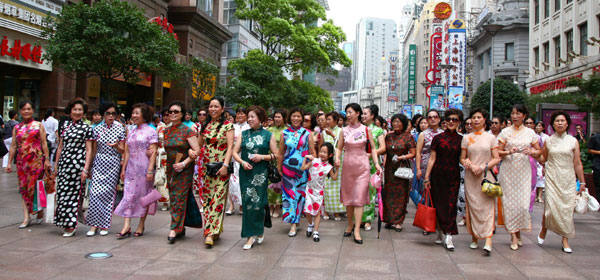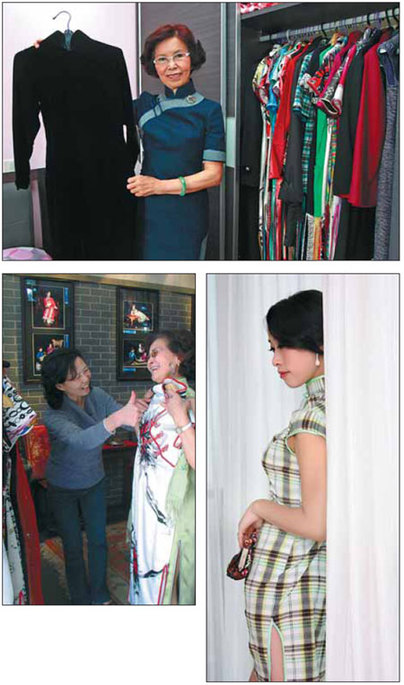Qipao chic
Updated: 2012-07-18 09:22
By Tiffany Tan (China Daily)
|
|||||||||||
|
 |
|
Shanghai Cheongsam Salon members show off their qipao on Nanjing Road, Shanghai. Provided to China Daily |
There's nothing more elegant or fashionable than a qipao, and while they are not as popular as they used to be they still have their dedicated followers. Tiffany Tan finds out why in Shanghai and Beijing.
 |
|
CLOCKWISE FROM TOP: Shanghai Cheongsam Salon founder Wang Weiyu displays her qipao collection at her home in Shanghai. Zhao Jing says wearing a qipao puts her in an indulgent mood. A Shanghai Cheongsam Salon member chooses a qipao at a ready-to-wear store in Shanghai. Gao Er'qiang / China Daily Provided to China Daily Xiari Mufeng / for China Daily |
Women unwinding on a weekend usually dress in jeans, shorts or a skirt and a T-shirt. Not Zhao Jing. The 27-year-old from Beijing dons a qipao to visit a park, drop by the supermarket or make tea at home. The figure-hugging traditional dress, with its distinctive mandarin collar and slit skirt, puts Zhao in an indulgent state of mind.
"In this kind of city, you work like crazy every day," says the Anhui province native, who is account and venue manager at a Beijing cultural exchange center. "When you're wearing a qipao, you feel like you don't need to hurry back home to cook or do other chores. You just enjoy the moment and relax."
Zhao began to regularly wear the dress - known as "cheongsam" in Cantonese-derived English - back in college, about 10 years ago. She now has six dresses in her collection.
Wang Weiyu, on the other hand, has almost nine times as many.
For the past five years, the traditional dress has become everyday wear for the Shanghai retiree, who conducts etiquette classes in local communities.
Among her 52 qipao, she has one with a slit at the back, instead of at the sides, made especially for cycling. She has cotton and linen qipao for running errands, woolen versions for winter and luxurious silk numbers for formal occasions.
She has the dress in solid colors, plaids, stripes, polka dots, tiny and bold floral patterns, traditional prints, lace, as well as embroidered and hand-painted designs. And of course, there are her denim pieces, which provide some insight into why she has become a major qipao advocate.
"Denim qipao are innovative and can attract the interest of young people," Wang, 63, says one rainy summer afternoon in her home in the southwestern suburbs of Shanghai.
"You are Chinese and have your own heritage. You cannot forget your traditional, ethnic culture Even if you're wearing international brand names from head to toe, your hair has been dyed blond and your eyes are colored blue, you're still Chinese. This cannot be changed."
In 2007, Wang established the Shanghai Cheongsam Salon to promote qipao use. The group's activities include an annual assembly, talks and trips around China and overseas - with all members decked out in their traditional attire, of course.
From an initial 40 women, the group's numbers have since grown tenfold. (The average age of members is 55, only 5 percent of the group is 30 years old and younger.)
Many of the members come from Shanghai and its neighboring cities of Suzhou and Hangzhou. Lately, Wang says, there has also been interest from women in northern cities like Beijing, Harbin and Xi'an, as well as southern cities like Guangzhou and Shenzhen.
The group now wants to bring this awareness to the next level: It's trying to garner government support to declare May 20 as national "qipao day".
"The first time salon members gathered for Chinese tea, and this was still within the community, not far from where we lived," Wang says. "More than half the women carried their qipao in their bags.
"They didn't dare wear them out on the streets. When they got to the teahouse, then they changed clothes. I teased them, saying, 'So what if I wear a qipao to go out? Will the police arrest me?'"
It may be a joke, but it's also a reflection of the qipao's changing fortunes in Chinese society.
The dress - a fusion of the sleeveless long vests and long-sleeved lined jackets of the late Qing Dynasty (1644-1911) - was popularized by Shanghai women in the 1920s. The earliest styles were actually relatively loose; they became tighter at the waist due to Western-tailoring influences in the '30s.
During that decade and the next, the dress became the height of Chinese fashion. It was worn by ordinary citizens, as well as movie stars and intellectuals. It served both as casual and formal wear and was paired with imported articles of clothing, like fur coats, shawls and sweaters.
But it went by the wayside in the '60s and '70s, when Communist revolutionary zeal swept China. The qipao, which was associated with bourgeois culture, vanished from public life.
In the '80s, following the country's "reform and opening-up", the dress reappeared. Since then, however, it has been worn mainly on special occasions, like wedding banquets, Spring Festival celebrations and international events.
"Present-day Chinese have long been looking for appropriate formal attire," says Liu Qi, a lecturer at the Beijing Institute of Fashion Technology and associate curator of the university's Museum of Ethnic Costumes.
"Because of the qipao's prestigious history, especially in the eyes of Westerners, and because it's not far removed from our life, it became Chinese women's first choice," she says in an e-mail.
To appeal to more consumers, vendors have begun offering modernized versions of the dress.
At Herderson Metropolitan, a mall on Shanghai's Nanjing Road shopping hub, a ready-to-wear qipao store gives a glimpse of the dress' reincarnations. Instead of the traditional mandarin collar, most of the items have U- and V-shaped, square, scalloped or sweetheart necklines. Some feature an organza overlay that mimics the traditional neckline.
The skirt slit is done away with on the knee-length dresses, and they all zip at the back. Some are empire cut; others are pleated along the bodice. Front overlaps and loop frog buttons are sewn shut and merely serve as decorations.
"Today's Chinese fashion integrates international trends, and people's concepts of beauty have undergone massive changes," says Jia Xizeng, a lecturer at Tsinghua University's academy of arts and design, who specializes in ancient Chinese garments.
"Because of the diversity of aesthetic needs, people are no longer transfixed on just one type of clothing," he says.
Women like Zhao Jing and Wang Weiyu, who wear their qipao every day or every week, are pretty unusual. It's especially unusual for younger women like Zhao, who came of age in a globalized, Western fashion-dominated world.
But Zhao doesn't mind sticking out in a crowd in her pink high heels and custom-made qipao in salmon pink georgette.
"I don't care if people stare at me," she says, holding up the dress in the summer light. "I just enjoy feeling elegant and carefree."
Contact the writer at tiffany@chinadaily.com.cn.
Related Stories
Shanghai legends 2012-07-13 11:16
Cheongsam exhibiting and promoting activity held in Shanghai 2012-07-02 15:38
Splendid cheongsams displayed at museum in Hangzhou 2012-06-21 16:25
Dressed in balloons 2012-06-18 09:24
Today's Top News
Rescuers race against time for quake victims
Telecom workers restore links
Coal mine blast kills 18 in Jilin
Intl scholarship puts China on the map
More bird flu patients discharged
Gold loses sheen, but still a safe bet
US 'turns blind eye to human rights'
Telecom workers restore links
Hot Topics
Lunar probe , China growth forecasts, Emission rules get tougher, China seen through 'colored lens', International board,
Editor's Picks

|

|

|

|

|

|





